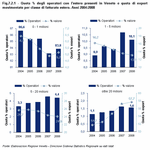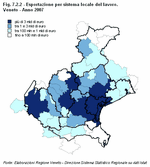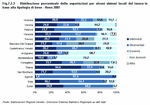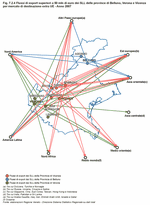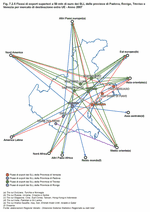In 2008 there were more than 28,000 Veneto businesses which operated on international markets, with growth of 2.3% yearly. Exporters are highly diverse. On the one hand, there are many small-sized enterprises (about 63% of the total) which have a limited export turnover i.e. up to 100,000 euro, accounting for 0.7% of regional exports. On the other hand, there is a small number of enterprises (60 that exceed 100 million euro) which alone make up almost 26% of regional exports
(Table 7.2.1).
If the percentage distribution of exporting businesses is analysed by amount of foreign sales, the increase in the relative weight of large-sized enterprises on the total value of regional exports clearly emerges, and it confirms the relevance of business size within the framework of ever more globalised markets. Businesses that succeed in selling in international markets are often the most innovative, oriented towards higher value added products where competition depends on factors other than price
(Figure 7.2.1).
In the last five years, regional entrepreneurs who stated they export goods for over 20 million euro have risen by over 100: from 356 in 2004 to 459 in 2008. Their share of exports has also risen: from 51.7 to 57.7%. Conversely, smaller-sized enterprises, i.e. businesses exporting less than 5 million euro, have decreased: between 2004 and 2008 they declined by 12.3%
(Note 1). In 2008, these businesses accounted for 94% of regional enterprises, but they only accounted for 18.3% of exports out of the regional total, compared to 22.6% in 2004.
The value of sales is also correlated with the number of destination markets. In 2008 there were slightly over 400 businesses in Veneto that exported to over fifty markets and accounted for over 34% of Veneto exports, whereas 77.4% of enterprises exports to fewer than 6 countries, accounting for almost 9% of foreign sales. A similar pattern is also found if enterprises are analysed by geographical and economic area
(Note 2). There are 382 Veneto businesses in all areas under consideration, or 763 if the ones operating in at least ten areas are considered; these account for about 44% of regional foreign sales. About 60% of total regional businesses only operate in one area-mainly EU27-and they account for 5.7% of regional exports.
Veneto businesses in the main areas of international trade are widespread: in 2008 there were 8,206 Veneto exporters within the EU (260 with an export turnover of more than 20 million euro); 13,210 in Eastern Europe; 8,707 in other European countries; 6,302 in North America; 5,616 in the Middle East; and 6,272 in East Asia.
Trade of industrial product parts as opposed to finished products is the component of foreign trade which has grown more quickly in the last few years. Research shows that intermediate goods and tools exported by Veneto businesses have risen sharply
(Note 3). In 2008, the share of capital goods and semi-finished products exceeded 60% of total regional foreign sales and almost 20,000 businesses were exporting such goods. Consumer goods accounted for about 38% of regional exports and almost 14,000 businesses were exporting ones "Made in Veneto".
There are 119 Veneto enterprises exporting at least five kinds of goods, which become almost 1,000 if exported goods are grouped into at least four categories, which account for 38% of regional exports. In 71.6% of cases, Veneto foreign trading firms export only one kind of goods. These are mainly intermediate products (31.1%) and capital goods (29.9%), which together account for 15.5% of Veneto's foreign sales.
In the last few decades, the development of local industry, which still accounts for a significant share of employment and exports, fostered the rise of leading firms that extend their business and manufacturing networks beyond their local area to form groups operating at an international level, ones that can also be medium-sized. These 'new multinational enterprises' are strongly oriented towards global markets and their success often contributes to establishing the international reputation of their area of origin (cf. case histories of some Veneto areas where the food and fashion industries have developed)
(Figure 7.2.2).
The Istat archive of foreign trading firms has been used to assign the flow of exports to the Local Labour Systems (SLLs)
(Note 4) in order to assess the size and relevance of networks in terms of trade flows concerning local manufacturing companies in Veneto. This system has been chosen because it makes possible more sophisticated analyses compared to analyses by province and is more specific than analyses by municipality.
The value of exports was assigned to the Local Labour System where the Veneto company has its parent (the company is usually the producer rather than the importer-exporter) or, in the case of non-Veneto businesses, to the Local Labour System where the largest local unit is located, i.e. the local unit with the highest number of employees
(Note 5).
The geography of regional exports relating to 2007 shows that 15 Local Labour Systems in Veneto
(Note 6) produce exports worth over 1 billion euro and together they account for about 88% of Veneto's foreign sales. The top five are the production systems of the five provincial capitals in the central area of Veneto (from Vicenza and Verona with 4.8 billion euro, to Treviso with 3.9 billion euro). Bassano del Grappa, with its exports accounting for 7.4% of regional exports, is the top Local Labour System which is not a provincial capital, followed by Castelfranco Veneto (5.9%), Arzignano (5.8%), Montebelluna (4.4%), Conegliano (4.1%), Thiene (3.8%), San Bonifacio (3.1%), Agordo, Este and Schio (2.2%)
(Figure 7.2.3).
In the last ten years, the improvement in world trade was supported by the growing fragmentation of production and it favoured companies specialising in the manufacture of capital and intermediate goods. An analysis of the patterns of exports of local systems by main groups of industries (RPI) shows that most local networks specialise in the sale of semi-finished goods and machinery. In the production systems of Vicenza, Padova, Venezia, Castelfranco Veneto, Thiene, San Bonifacio, Agordo (where the sale of capital goods (Note 6) accounts for 97.4% of total exports), Este and Schio, the share of exports of these goods accounts for over 70% of total foreign sales.
Conversely, Montebelluna (74.2% of non-durable consumer goods), Arzignano (58.7% of non-durable consumer goods) and Bassano del Grappa (36.5% of durable consumer goods and 24.9% of non-durable consumer goods) specialise in the export of consumer goods. In these production systems, which specialise in the traditional "Made in Veneto" products, the combination of technology and design plays a fundamental role in competing with new emerging countries, which are often dependent on the low cost of labour.
The leading outlet market of all Veneto's local systems is the EU, which accounts for more than 50% of total sales, with the exception of the production systems of Grezzana (47.1%), Agordo (44.6%) and Venezia (47.9%). Trade with interesting, potentially expanding markets must be regarded as an opportunity to penetrate new markets, especially for the companies that, by merging or setting up local networks, intend to confront processes of internationalisation and industrial innovation more effectively. The areas with better development prospects are those of the new emerging countries; efforts should be channelled towards them
(Figure 7.2.4) and
(Figure 7.2.5).
An analysis of exports of Local Labour Systems to non-EU areas confirms that the core of regional trade has moved towards Eastern Europe and East Asia. These areas, together with North America, are strategic for the exports of all the main industries in Veneto.
In 2007, there were 16 Veneto local systems with over 50 million euro worth of exports to Eastern European countries, mainly Russia and Croatia. There were 15 exporting more than 50 million euro worth of goods to East Asia (China, Japan, Hong Kong, South Korea) and North America. Other markets for Veneto's industries are: the Middle East, with 11 local systems exporting more than 50 million euro worth of goods, mainly towards the United Arab Emirates, Saudi Arabia and Qatar; Latin America, with 10 local systems which have trade networks exporting more than 50 million euro worth of goods, mainly to Brazil, Mexico, Panama and the Bahamas; and North Africa, with 7 local systems with foreign sales of more than 50 million euro.
Conversely, exports to Central Asian countries are still limited. There are two production systems-Padova and Verona-where foreign sales to the Indian subcontinent exceed 50 million euro. With their skills and organisation, Veneto companies need to establish a stronger trade network to penetrate this new market whose growth rates will be huge in the next few years.
The demand for foreign goods by India and by other emerging economies will contribute significantly to the recovery in international trade, and the sustained growth of a new class of consumers with a purchasing power similar to those of citizens in advanced countries-estimates state there will be over 100 million of them by 2020- will enable Veneto's firms to add these markets to their traditional ones.






